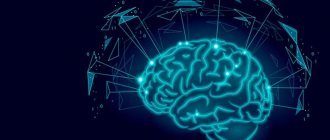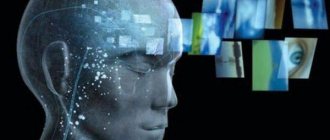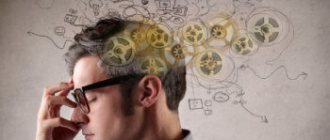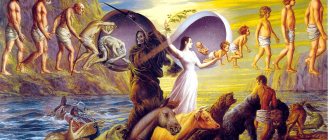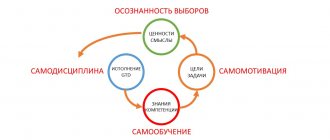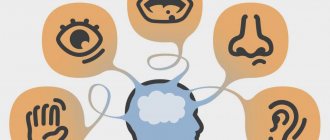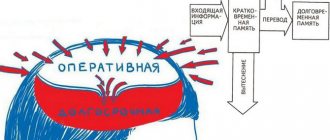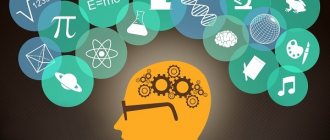Genetic memory in science
Imagine a puppy who is used to the comfort and care of home, but suddenly finds himself on the street and being thrown stones.
There must be an imprint of this painful experience somewhere? At least, it is after this that the puppy flinches when a person throws a stone or picks up something from the ground. This is what the German zoologist Richard Zemon reasoned at the beginning of the twentieth century. He suggested that when a certain stimulus acts on the body, a “memory trace” remains in it - an engram. The collection of engrams is “mnema” (in honor of the goddess of memory Mnemosyne). This concept came to be called mnemism. Zemon believed that with the help of engrams, information about the impact of the environment on a living being is transmitted from generation to generation.
In 1914, Freud wrote: “All our preliminary psychological propositions will someday have to be transferred to the soil of their organic basis.” Genetics was then in its infancy. A century later, in 2012, a group of scientists led by Nobel laureate Susumu Tonegawa conducted an experiment on mice.
Rodents were placed in a cage that was unfamiliar to them and shocked, recording which groups of neurons responded to fear. After this, the animals were transplanted into another cage, the same neurons were illuminated using fiber optics - and the mice began to be afraid! This is how scientists discovered a “memory store” - a system of neurons and genes that remembers a specific traumatic episode.
The patterns of fear found were called engrams. Today, scientists are able to illuminate engram cells of the hippocampus - what Zemon dreamed of seeing. So his concept received a rebirth a hundred years later and began to appear more and more often in scientific literature. For example, in an article published in January 2021, neurosurgeons from Stanford University summarized everything that is known about hippocampal engrams to date.
An engram is a set of neurons involved in an experience. Experiences can be recalled by activating these neurons. Neuroscientists have yet to understand how complex information about an experience is compressed into an engram.
Genetics have found that in mice, the memory of fear can be passed on to subsequent generations, not only to children, but also to grandchildren.
Researchers from Emory University Medical Center conducted an experiment with three groups of mice. Males from the main group were sprayed with acetophenone (a liquid with the smell of bird cherry) and at the same time they were shocked. The mice began to associate the smell of bird cherry with pain and ran away without waiting for the electric shock. Their cubs also reacted to the smell: they shuddered, jumped, froze in place, or started running, although no one shocked them. Increased sensitivity to odor continued in the third generation. Moreover, in two control groups, where the mice were either not frightened at all or used another substance, there was no reaction to acetophenone.
What does “hypersensitivity” to odor mean at the molecular level? When the animal inhaled a substance with an odor, groups of neurons in the epithelium of the nose and in the olfactory lobe of the brain were activated. The descendants of “frightened” mice had more such excited neurons.
Maybe the parents simply taught the mice to be afraid of the smell of bird cherry? Researchers implanted embryos from the young animals of “scared” animals into surrogate mothers. The born mice never saw their biological fathers - but they reacted to the smell in the same way. This proves that the reaction is transmitted at the biological level, and not at the behavioral level.
How does this relate to genes? When exposed to mice, their nucleotide sequence did not change, no mutations occurred - only gene activity increased (this direction is called epigenetics). Scientists analyzed the DNA section of mice where the acetophenone odor receptor gene is located and found that both the gene and the receptor worked more powerfully. University College London professor Marcus Pembray suggested the research could help us understand how “ancestral memory” of traumatic experiences is passed on to other generations in humans – and what role these experiences play in the development of diabetes, obesity and mental illness.
The essence of the problemedit
So what do genes give us? A lot really depends on them - body type, predisposition and immunity to diseases, eye color, innate strength, reaction, vision, and the like. In general, one person is born a hero, another suffers from weakness, one girl can eat tons of hamburgers and not gain any weight, another can count calories all her life and sweat in the gym (however, there is an opinion that she counts calories and then cries because that in principle he cannot resist eating the cake), one word - genes.
What does training give us? Much. Mind training, of course, is unlikely to make a person a genius, but without it, erudition and the ability to process information will not be able to develop (tested on Mowgli children), and the brain will not be able to respond to a threat quickly (if only because a trained military man can at first glance, recognize a threat, even without seeing it, assume its presence and direction, where to expect it from; and a civilian, if he hasn’t watched a lot of militants, which is also experience, will point his finger at the bomb, having no idea what it is and why it’s ticking ). Without a course of physical training, even if a person has a genetic predisposition to be strong and dexterous, these qualities will not be able to manifest themselves properly - the body, of course, is strong, but it will not be able to use strength without injuring itself. Rarely experiencing pain, you will not learn to endure it, and without practicing shooting, you will not become either a sniper or an expert in firing from the hip in Macedonian style right at the target.
Thus, initially the specialists were ordinary people who had gone through school, university, basic combat training, junior commander courses and were covered with scars from numerous practice in combat conditions, then they tried to upgrade them to the heights of the potential inherent in the genome, and when it turned out that without training, they are brutally raked from simple but trained ones, the authors began to think about what to do next. Well, of course, you need to integrate knowledge and experience into the firmware, and then quickly implement it - but how? There are two ways: either directly into the genome, or stitched into the brain using a hypnotic device. Both are impossible from the point of view of reality (yet).
...and in anti-scientific theories
Before the structure of DNA was discovered in 1953 and the basis for studying the work of cells appeared, humanity managed to break the woods. In the 19th and 20th centuries, several theories arose related to genes, about which little was understood at that time:
- telegony - the idea that children inherit characteristics from the mother's previous partners;
- Eugenics is the idea that a population can be “improved” because intelligence and talent are inherited. Another side of it is that in the USA, and later in Germany, criminals, the weak-minded and the sick were forcibly sterilized;
- Antisemitism is the idea that character traits are inherited within a race and that Jews are genetically different from other nations for the worse.
Neuroscientist Eric Kandel writes in his autobiographical book In Search of Memory:
“This notion goes back to the doctrine of deicide long taught by the Roman Catholic Church. As Frederick Schweitzer, a Catholic who studied Jewish history, argued, this doctrine gave rise to the idea that Jews were responsible for the death of Christ (until recently, the Catholic Church did not renounce these ideas). According to Schweitzer, this doctrine assumed that the Jews, guilty of deicide, as a race possessed an innate lack of humanity and therefore must be genetically different from other people, be subhuman."
Kandel recalls the events of 1938 in Vienna, when the Nazis broke into the homes of Jewish families, trashed apartments, broke the windows of synagogues, forced Jews to scrub the streets with toothbrushes, and kicked out Jewish children, including nine-year-old Kandel, from schools. These episodes from childhood awakened his interest in the psyche and led Kandel to science - in 2000 he received the Nobel Prize for research in the field of cellular and molecular mechanisms of memory.
One of the leitmotifs for Holocaust survivors was the phrase “Never forget”—Kandel saw his scientific duty in studying the biological basis of this motto. It is interesting that the descendants of the Nazis continued to believe in the “power of genes” and the heredity of the psyche.
The great-nephews of Hitler and Goering, feeling guilty for what happened and seeing their external resemblance to their ancestors, agreed never to have children or even to be sterilized so as not to “breed criminals.”
The eldest son of Hitler’s personal lawyer, Norman Frank, did the same. Some descendants of concentration camp commandants tried to commit suicide. This is described in the films “Hitler’s Children”, “The Last of Hitler” and the Russian project “Children of the Third Reich”. The tabloid press picked up the agenda and, in search of the non-existent “Hitler gene,” began to look for the descendants of the Fuhrer.
How is the problem solved?
“The genogram shows exactly how and where the behavior pattern was formed. Based on this, the specialist determines what law governed the patient’s life and why the person could not behave differently. The law is important to define and understand in order to set a precise new direction in a person’s life and stop repeating this or that experience.
— A new constructive law is formulated, and a person receives clear instructions, because to change the law, one must also track and change conditioned reactions, previous beliefs and take new actions.
“Then the person goes through the experience in order to strengthen his new understanding and get the desired results.
It may seem that the laws in question are very similar to regulations. However, according to a psychogeneticist, law and attitude are different things: “A psychologist can change attitudes, but not the law, and if you don’t change the law, then DNA will lead a person to the same experience. Many psychologists improved their skills with Boris and Tatyana Sorin . So this is not mysticism, but education, which is approved by our Ministry of Education and Science.”
In esotericism
In pursuit of sensations, journalists continually invent stories about “genetic memory” and stories in the spirit of “paranormal phenomena.” Let's remember the fake news that “a person uses only 10% of his brain” - but then what about the remaining 90%? Ancestral memory and supernatural abilities, of course! As a rule, myths and conjectures surround what is difficult or impossible to explain at the layman level.
Take, for example, the award-winning American psychologist and bestselling author Paul Piersol. In the book “The Heart Code” (1998), he presented supposedly scientific evidence of cellular memory: as if the heart “talks to the brain,” “remembers” and communicates with other hearts. Some heart transplant patients have reported that they developed new memories and suddenly changed preferences: they became similar to their donors in temperament, and began to like the same food, music and places in the city that their donors liked.
Another example is a 2003 Komsomolskaya Pravda article about saleswoman Natalya Beketova, who, after fainting, suddenly “remembered” 120 languages. At the same time, a genetic memory of the same number of lives she had lived awakened in her - supposedly “genes that were in a recessive state were to blame for this.” Canadian-American psychiatrist Ian Stevenson collected similar stories about children who “remembered” and talked about their past lives. Stevenson used them to support the theory of reincarnation.
In addition, since the 1960s, parapsychologists have used LSD, holotropic breathwork, and regressive hypnosis techniques to make patients remember past lives or their own conception. In Israel, this technique was officially banned in 2009 after complaints from patients.
Of course, modern science will not take such practices seriously. But what if we look at it from the point of view of human desire for the transcendental or artistic fiction?
The mechanism of manifestation of memories from past lives
Each of us experienced a feeling of deja vu. It appears completely unexpectedly and looks like confidence that you have already experienced the current moment before, have seen what you see now and have been in a place where you have never actually been.
Many scientists are skeptical about the theory of rebirth and explain déjà vu as something read in a book, seen in a movie, or invented while reading a book.
At the same time, there are moments when deja vu causes an avalanche of memories of a past life. This happened to a friend of mine who was cutting lemon for tea. When the tea was ready, and Ilya settled down with a mug in front of the TV and took a sip of the aromatic drink, he simply choked on the sudden flood of memories.
American psychologist Frederick Lenz studied similar cases for several years. The result of his research was the book “Times of Life,” in which he described all his observations. According to Dr. Lenz, memories of past lives visit a person during meditation, in dreams and during déjà vu.
In addition, the specialist noticed that many of those who experienced this noted changes in their physical and mental state. These changes manifested themselves in the form of euphoria, a feeling that the whole world around was becoming brighter and seemed to vibrate slightly. After such a shock, people who remembered a piece of a previously lived life spent some time in a state of stupor.
In philosophy, literature, dance
Where did this idea even come from? Can a person “remember” something that he has never experienced himself?
Plato believed that a person experiences the world with the rational part of his soul. And since the immortal soul, before moving into the body, was in the world of “ideas” and contemplated the truth, it knows about everything in the world - both in earthly and in the other world. Plato first formulated his famous doctrine of recollection in the dialogue “Meno”. In it, Socrates talks with a boy, Meno's slave, asking leading questions, and he independently comes to the Pythagorean theorem. Therefore, “true opinions” are not acquired, but are already inherent in a person from birth, simply forgotten. And to teach something just means to force the soul to “remember” it - to “awaken” it with questions, feelings and tireless searches.
“It turns out that a person has true opinions about what he does not know? And now these opinions stir within him like dreams,” says Socrates.
True opinions are not permanent, they “escape from the human soul and therefore are not valuable until someone binds them by thinking about the reason ... and this is recollection.” This is how opinions become knowledge. In the dialogue "Phaedrus" a person understands the "idea" as a memory of what "the soul once saw when it accompanied God."
Over the next two millennia, the theory of innate ideas and the immortal soul was developed and reinterpreted by other philosophers. Philologist and historian of St. Petersburg State University Boris Averin explains Plato’s theory that “all knowledge is memory”:
“Here we mean knowledge that determines our existence, its meaning, our perception of the world. Before incarnating, the soul resided in a place where harmony, beauty and bliss reigned. And when she incarnated, she forgot this state. We have forgotten the state of bliss, but we still know it. When I perceive the beauty of nature, when I love, when I am creative, I suddenly experience a state that brings me closer to the memory of what I have known from eternity.”
This idea was also reflected in literature. In one of his interviews, Boris Averin talked about Ivan Bunin’s novel “The Life of Arsenyev”: “Bunin writes about childhood memories, memories of the soul - all this was completely closed to me.
According to Bunin, infancy is sad because the soul has not yet completely forgotten how it experienced bliss before its birth.
Bunin perceives life incredibly acutely, in a way that most people cannot perceive, to whom existence seems monotonous, painted in inexpressive gray and white tones. And he perceived the material world with extraordinary power. He had such strange states of consciousness when he seemed to remember not only his present, but also the distant past beyond his own birth. And when he asked Leo Tolstoy about such experiences, he replied: I even remember how I was once a kid.”
Averin gives examples of famous personalities who did not seem to receive knowledge, but remembered it:
“Vladimir Kazimirovich Shileiko, the second husband of Anna Akhmatova, studied Mesopotamia, the Sumerians, ancient, long-forgotten cultures. In three years he begins to perceive the culture of the 15th century BC. e. so deeply that his works are studied by specialists who have been doing this all their lives. And there are quite a lot of such people. Vladimir Solovyov, Vyacheslav Ivanov, Andrey Bely, partially Blok. They remember something that many people spend years on.”
Of course, we cannot penetrate into the area of primordial memory from the point of view of physics and physiology, says Averin. “But this is if we take a physical person, and what if we take his consciousness? It can be defined as tabula rasa: I was born and I don’t know anything, I’m like a blank slate on which my parents, society, books and the knowledge I receive write. Or maybe knowledge is inherited, and my brain carries traces of previous perceptions, previous existences. And this is what we need to remember. Isn’t this what the Greeks say about: “Know yourself?”
The philosopher Mircea Eliade devotes several chapters of the book “Aspects of Myth” to the myths of memory and oblivion, including in ancient Greece. The Greeks distinguished between two types of memory:
- “primary” - knowledge about the beginning of time,
- “historical” - previous existences, events from the life of an individual and general history.
It was believed that poets inspired by the muses, those who, thanks to the “prophetic gift directed to the past,” can know the origin of the world, and those who believe in the reincarnation of souls and are able to remember their previous lives (like Pythagoras and Empedocles) were not subject to oblivion.
Soviet paleontologist and science fiction writer Ivan Efremov in 1942 wrote a very bold story for those times, “The Hellenic Secret.” The narration is told on behalf of a professor named Israel Abramovich Faintzimmer, who devoted his life to the psychophysiology of the brain, and during the war he worked in hospitals. A soldier comes to the professor with unusual complaints. After a shell shock, he is tormented by strange visions, and he is sure that he sees Hellas in a dream.
“Leontyev complained of pain in the upper part of the back of the head, and it is there, in my opinion, in the posterior regions of the cerebral hemispheres, that the most ancient connections - memory cells - nest. Obviously, under the influence of enormous mental stress, ancient imprints began to emerge from the depths of the brain, hidden under all the wealth of memory of his personal life.”
The soldier turns out to be a sculptor who dreams of sculpting a statue of his beloved, but is tormented by the choice of material. In his visions, he enters the workshop of distant ancestors who lived in Cyprus and discovers an ancient recipe on the table - how to make ivory soft, like wax. The professor explains this by saying that the recipe was extremely important, so strong connections were formed in the memory of the ancestor, which were fixed for transmission in the mechanism of heredity. Will and exertion of all his strength helped the soldier remember what he needed so much.
“As is accepted by modern science, memory is not hereditary,” says Feinzimmer. “But I think that the experience of countless generations has given us an unconscious understanding of perfection, perceived in the form of beauty, and this concept is already imprinted in memory - that unconscious memory that is inherited from generation to generation.”
However, the professor admits that in rare cases, combinations of nerve cells can transmit “pieces of conscious memory” - about something that the person himself has never experienced.
Later, Efremov developed the same ideas in the novel “The Razor’s Edge,” the title of which means “the imperceptible line between consciousness and subconsciousness.” According to the plot, the doctor suggests that the patient “stimulate the memory nodes of hereditary information” with the help of LSD in order to awaken memories of primitive ancestors and travel back from 1961 hundreds of thousands of years ago. But after a week, “fear for the person’s mental health did not allow the experiments to continue.”
Since Efremov himself was a scientist, he tried to give a scientific explanation to everything - in his works it is worth separating science from artistic fiction. By “hereditary memory” (information, mechanisms) he means “the instinctive memory of cells and the organism as a whole, that autopilot that automatically guides us through all manifestations of life,” and this generally corresponds to reality. But the fact that in rare cases memory “can break into consciousness with the possibility of decoding it in mental images” is fiction.
There are quite a lot of stories similar to Efremov’s. For example, Kipling's "The World's Strangest Tale," written in 1891, is said to have inspired Jack London's "When the World Was Young" and "Before Adam" (1906–1907). Since childhood, the hero of the latter dreamed of scenes from the life of primitive ancestors, when a person “was just becoming a man.” A college professor explained to him that a common dream in which a person falls from a height is a manifestation of “racial, ancestral memory”: our ancestors fell from trees and experienced the fear of death, which generated molecular changes in brain cells. These changes were “transmitted to the brain cells of descendants, thus becoming a ancestral memory.” It's more about instinct and what would later be called the "reptilian brain," but at the time London used the term "germplasm" to mean "the medium that would transmit this memory from generation to generation."
But the hero of London’s novel “Interstellar Wanderer” travels precisely through his past lives:
“We, newborn babies without experience, were born with fear, with the memory of fear, and memory is experience... During this period, everything that I had been in tens of thousands of previous existences was wandering and stirring in me; it all muddied my molten “I”, striving to incarnate in me and become me... Other voices broke through my voice - the voices of people of past centuries, the voices of foggy hordes of ancestors.”
In the fourth part of Efremov’s novel “The Razor’s Edge” it is said:
“Hallucinations... lead us to the dizzying possibility of looking through man himself into the abyss of millions of past centuries of his history, awakening in his consciousness a coded memory fund. The first scientific formulation of the problem of genetic memory at the beginning of our century belongs to the writer Andrei Bely. He formulated the possibility of “paleontological psychology” and talked about treating the layers of the subconscious, inscribed in our psychological structure, like fossil layers in geology... Our task is not only to split consciousness and subconscious, but to open the subconscious memory and, reflecting it in consciousness, obtain a decoding "
As philologist Natalia Mokina notes, in the works of Andrei Bely and other poets of the Silver Age, the motifs of primordial memory, timeless essence and “unearthly” beginning in man acquire special significance. To use the words of Vyacheslav Ivanov, many Russian poets “live in myth,” recognizing ancient subjects as “ancient memories,” as “ancestral memory.” In the poem “The House of the Poet” by Maximilian Voloshin there are the lines: “All the thrill of life of all centuries and races lives in you. Always. Now. Now". He explained this idea in detail in his early article “Revelations of Children's Games.”
Philologist Sergei Bocharov presents all Russian literature as a “branched memory,” a single circulatory system, which is why the book of his essays is called “Genetic Memory of Literature.” The first article in it is devoted precisely to “literary memories”, “memory of the genre” (Bakhtin’s term) and amazing coincidences in the works of authors from different eras.
The motive of a powerful connection with ancestors and descendants has been and remains one of the key ones in poetry and memoir literature. As the poet Anatoly Kobenkov wrote in the poem “Autumn”:
When we sort our herbs and put cucumbers in tubs, our forefathers call out to us like birds from an olive grove.
Or in the famous poem “Life, Life” - Arseny Tarkovsky: “My immortality is enough for me, so that my blood flows from century to century.”
The idea of memory of ancestors is even realized in ballet! The founder of modern dance, Martha Graham, titled her autobiography “Blood Memory.” She wrote:
“In all people, especially in dancers, with all the power of their lives and bodies, the memory of blood speaks. Each of us has inherited the blood of our father and mother, and through them the blood of their parents and the parents of their parents, and so on into the depths of centuries. We carry within us thousands of years of this blood and its memory. How else can we explain the instinctive gestures and thoughts that come to us when we are not ready for them or expecting them?
Perhaps they come from the depths of memory of a time when the world was still chaos, when, as the Bible says, the world was still nothing. And then, as if through a slightly open door, light appeared.”
Graham quotes William Goyen from The House of Breathing:
“We are the bearers of lives and legends—we have come to know the invisible frescoes on the inner walls of our skulls.”
Often, Graham says, the dance is created out of a desire to find these hidden murals. When Marta choreographed another dance, she did not try to explain it with words:
“I always hear the footsteps of my ancestors behind me, they push me when I create a new dance, and their gestures flow through me. It doesn't matter whether they are good or bad, they are part of my family. You reach a point where your body becomes something else, it carries with it a whole world of past cultures, an idea that is very difficult to express in words.”
Graham admits that she has always been curious and interested in the lives of other people and creatures: “Empedocles once said about this: “I was once a boy, I was once a maiden, I was also a bush, I was both a bird and a dumb fish of the sea.” “. In other words, drops of memory from these past selves are flowing through me - not reincarnation, not transformation, nothing like that. I’m talking about the divinity of memory, fragments of memory, about extraordinarily valuable things that we forget and which our body and mind decide to remember... Like Emily Dickinson: “Instinct picks up the key that memory has abandoned...”
Martha Graham did not consider herself a genius dancer, but preferred to imagine herself as a sort of “getter”—a golden retriever, “getting things from the past or from our shared blood memory.”
Notes
- Dictionary of a practical psychologist. — M.: AST, Harvest. S. Yu. Golovin. 1998.
- Explanatory dictionary of psychology. 2013.
- Trainer's Dictionary. V. V. Gritsenko.
- Rodolfo R. Llinas (2001). I of the Vortex: From Neurons to Self. MIT Press. pp. 190-191. ISBN 0-262-62163-0.
- Encyclopedic dictionary of psychology and pedagogy. 2013.
- Louis D. Matzel (2002). "Learning Mutants". In Harold E. Pashler. Steven's Handbook of Experimental Psychology. John Wiley and Sons. p. 201. ISBN 0-471-65016-1.
- Timothy L. Strickler (1978). Functional Osteology and Myology of the Shoulder in the Chiroptera. Karger Publishers. p. 325. ISBN 3-8055-2645-8.
- Brian Keith Hall, Roy Douglas Pearson, and Gerd B. Müller (2003). Environment, Development, and Evolution: Toward a Synthesis. MIT Press. p. 17. ISBN 0-262-08319-1.
- Robert F. Almeder (1992). Death and Personal Survival: The Evidence for Life After Death. Rowman & Littlefield. pp. 28-29. ISBN 0-8226-3016-8.
- Susan J. Blackmore (1999). The Meme Machine. Oxford University Press. p. 60. ISBN 0-19-286212-X.
- John Donnelly (1994). Language, Metaphysics, and Death. Fordham Univ Press. p. 356. ISBN 0-8232-1562-8.
- Book Nameless Cults, preface to the story Black Eons
In sociology, history, psychology
Natasha Rostova, in the second volume of War and Peace, whispered to Sonya and Nikolai: “You know, I think that when you remember, remember, remember everything, you remember so much that you remember what happened before I was in the world...”
In the 19th and 20th centuries, the topic of inherited memory was of great interest to philosophers, psychologists, historians and writers. Many have thought that cultural evolution occurs parallel to biological evolution, and that in addition to the individual level of memory, there is also a collective level. One of the first to formulate this was Carl Gustav Jung in his theory of the “collective unconscious” and archetypes.
Each person and his community inherits from their ancestors a huge amount of ideas about the past, traditions, images, material culture and methods of adaptation - this ensures the continuity of the development of societies over the centuries. German Egyptologist and historian of religion Jan Assmann called this phenomenon cultural memory. It is noteworthy that he develops the theory of “collective memory” of the sociologist Maurice Halbwachs and the theory of “social memory” (the wandering of the same images in culture) of the art critic Aby Warburg, who, in turn, relied on the concept of mnemism by Richard Zemon.
By the way, the word “meme” was first used by Richard Dawkins in 1976 in his book “The Selfish Gene.” A meme is a unit of cultural information that is transmitted non-genetically: “The meme of, say, belief in an afterlife is realized physically millions of times as a structure in the nervous systems of individuals around the globe.”
There is another type of memory that is passed on from generation to generation. American sociologist and Columbia University professor Marianne Hirsch in 1992 proposed the term “postmemory” - this is the memory of what people did not experience themselves, but “remember” from the stories of relatives, memoirs, photographs and films.
Marianne Hirsch is quoted by the poet Maria Stepanova in the romance “Memory of Memory,” dedicated to her ancestry: “Growing up under the weight of an all-consuming hereditary memory, under the control of narratives that existed before you or your consciousness was born, means risking the fact that your their own stories will go aside or even be erased, giving way to their predecessors.” In the 20th century, Stepanova writes, the inhabitants of Russia had to go through a whole “traumatic enfilade” from disaster to disaster, from revolution to war, from famine to massacres.
However, a person is influenced not only by narratives, not only by oral, written and visual stories about what he knows from somewhere. He may be given a “memory” of something he was never told about, on an emotional level. Often this is due to family secrets and the hushing up of trouble.
“For example, a person returned from captivity,” says Evgenia Germanovna Troshikhina, associate professor of the Department of Developmental Psychology and Differential Psychology at St. Petersburg State University. - How will he look at his child? In his eyes there is no longer security and freedom - he will be afraid of something all the time. The child will feel this and grow up with the desire to return his father to a joyful, carefree state - he may carry this away as a feeling that he failed in the task, did not help his father. If they told him that his father was in captivity, he was beaten and humiliated, it would give meaning to what was happening, it would help explain everything.
...In addition, there is such a phenomenon as “replacement children.” Let’s say a mother’s small child died, and she did not live through the loss, did not mourn, did not grieve. She decides to give birth to him again, but the next child turns out to be different from the one who left. And it’s in the air: we weren’t waiting for you, but for someone else. When a child dies young, he remains idealized because he can do no wrong and will always be better. Therefore, the next one has to justify himself, to prove that “I am here by right.” In the future, such children may develop serious psychological problems, the main of which are a constant search for identity, an internal feeling of emptiness, frequent depression, and an increased sense of guilt.”
It turns out that the child’s life is poisoned by memories that are not his own - and it is quite possible that this will affect not only himself, but also his children. In psychology, the non-genetic transmission of trauma across generations is called transgenerational trauma.
All children grow up following the examples of their parents, absorb everything they see, copy human relationships and behavior patterns. This is what Eric Berne called the family script, and journalists call the generic script - the repetition of family mistakes, which people often want to attribute to genes.
“According to statistics, people who have someone close to them commit suicide are more likely to commit suicide,” says Evgenia Troshikhina. - When a person has a difficult situation, he accepts this as a possible way out: if he allowed himself, then I can allow it too. Of course, this affects children, because suicide is impossible to grieve in the same way as any other loss, they are silent about it.
Or why does a girl whose father was an alcoholic often find an alcoholic as her husband? Because she knows how to live with him.
Or it is known that people from orphanages often transfer their children to an orphanage: they say, we were raised to be good people, and that’s where they will be raised. It is difficult for them to show feelings for children in public: kissing a child in front of others seems indecent. Therefore, they need to be taught step by step how to be mothers and fathers.”
Relatives and other members of society show children how to be human in this society and how to adapt to living conditions. This is how traditions are passed on.
“Anthropologist Margaret Mead studied child care among different peoples,” says Evgenia Germanovna. “For example, in an area where you need to be a brave warrior, otherwise tigers will eat you, children were placed in baskets made of hard rods, where it was very painful for them to lie. But the child became a brave warrior. And when Mead, in a company of farmers, said that Americans put a child in a separate crib, they looked at her as if she were a soulless mother: how can that be, you have to sleep with the child, otherwise he will be afraid. This upbringing supports the way of life: they cultivate the land together.”
The expression “memory of generations,” on the one hand, smacks of some kind of mysticism, esotericism, and has the flavor of another fried story from the yellow press. On the other hand, it absorbs entire layers of philosophical and cultural meanings. And thirdly, it reflects the continuity of science and gives hope for new discoveries.
Description
Genetic memory is a hypothetical phenomenon consisting of genotype-based “memory” for biological events that occurred during the evolution of a biological species. The word "memory" is used in a metaphorical sense to denote a genetically encoded propensity for certain behaviors and patterns of action that are the vestiges of evolutionarily important changes in the species. As an example: fear of falling and reflexive reactions to falling objects are examples that reflect the evolutionary adaptive response that any successfully developing primate species with a high body mass-to-surface ratio must have.
Genetic memory considers a number of behavioral acts inherent in animals and humans, mostly in the early age category. Genetic memory allows a newborn to preserve his life until he accumulates sufficient experience. The carriers of gene memory are nucleic acids, united in chromosomes and genes that facilitate the storage and accumulation of information. Includes unconscious actions, whether unconditioned reflexes or a set of fixed actions. Genetic memory is characteristic of all species of animals and in newborns is of primary importance in relation to phonetic memory - memory based on individually acquired experience and learning. As a consequence, phonetic memory is responsible for newly acquired information and experience, which is used in further generations by genetic memory.
In the modern interpretation, languages are considered as part of genetic memory. The fact that humans can have languages is a property of the nervous system that is present at birth, and is thus phylogenetic. At the same time, the perception of a set of phonemes is characteristic of adverbs formed through ontogenesis. In fact, there is no genetic predisposition to any one language. For example, children of a particular region are not genetically predisposed to speaking local languages. This refutes the relevance of gene memory to Lamarckism.
According to Jung's theory, in relation to humans, genetic memory is the collective unconscious. This is the experience of human ancestors, represented by the nervous structures of the brain. Carl Jung also attributed some mystical elements (connotations) to the term.
Different ideas about life
When several generations in a family live completely differently, they look at life differently, then it is not difficult to trace their similar history of experiences, events that were repeated over and over again, absolutely ridiculous small coincidences. By the way, if you look deeper, you can always find a reasonable explanation for all common habits.
The family scenario itself is very uneven. After all, in certain years families have to cope with problems. At that moment it was an absolutely correct reaction. Yes, it worked, and subsequently they began to use it everywhere, despite the initial situation.
There is a rather funny life story about a married couple. After marriage, the young husband noticed that when frying meat, his wife cut the piece into smaller ones. This surprised him and he asked why she was doing this. The wife said that her mother and grandmother did this. He decided to find out the answer from his grandmother. She replied that she just had a small frying pan, and a whole piece of meat wouldn’t fit there. That's why she always cut the meat into pieces.
It turns out that when we follow a certain scenario, we don’t think about our actions at all.
Obstacles
Everyone can awaken their ancestral memory, but to do this it is necessary to eliminate various factors that hinder them. These include:
- low energy level;
- incest;
- donation;
- consumption of genetically modified foods;
- connection to the Christian egregor;
- distortion of language;
- failure of the body's naturalness;
- drug and alcohol addiction;
- vaccination;
- slagging of the body;
- doing bad things;
- introduction of foreign genetic materials into the body.
Basic terms and concepts
Scientifically speaking, genetic memory is nothing more than a set of reactions determined by heredity and transmitted to an individual through genes. At the same time, the concept of memory is used to denote a subject’s propensity encoded in genes for certain types of behavior, which he can implement unconsciously in everyday life.
“Memory of the race” (biological, genetic or racial memory) is located in the depths of the nervous structures of the human brain and appears only occasionally. A person can feel it, for example, when he is visited by some vague pictures, incomprehensible sensations or emotions.
The concept of genetic memory can be considered in the most striking example, when a child, while still in the mother’s womb, sees dreams. Such manifestations belong to the sphere of genetic memory and help explain all the skills that the baby demonstrates when born.
We recommend: What is psychogenetics?
By learning while watching dreams, a child is able to master certain skills. Suffice it to recall the cases when recently born children demonstrate their ability to float on water. Do you think they were taught to swim? No. The acquisition of this skill by newborns is fully explained by the theory of the presence of gene memory in the subconscious. And the most surprising thing is that without additional support and development, this skill will be lost over time.
Over the course of many years of research and experiments, scientists have found that infants are capable of using hereditary gene memory up to 2 years of age. Subsequently, some memories and images gradually fade into the background, and some disappear altogether. As the child grows up and acquires new knowledge, the ancestral memory becomes practically closed to him.
Moreover, for an adult, the “bins” of his subconscious with the memories of his ancestors will be inaccessible while he is in a meaningful state. The human brain will block any manifestations of hereditary reactions to eliminate mental health imbalance. The thing is that successful attempts of the subconscious to throw out the memories of previous generations are fraught with a split personality of a person.
We recommend: Imprinting is
As a rule, genetic memory manifests itself in conditions of emotional outbursts, when a person acts unconsciously, as well as during sleep. But the manifestation of gene memory can also be stimulated artificially by putting the subject into a state of trance or hypnosis, while “turning off” his consciousness. In other cases, a similar phenomenon occurs if the human subconscious needs to reproduce encoded data hidden in genes and received “inherited” from previous generations.
Why is it important?
Awakening ancestral memory will help a person to know himself, reveal potential opportunities, and join the spiritual experience and wisdom of his ancestors. Just imagine having 126 ancestors inside you in the form of a huge flow of energy.
Alexey Mosin pays great attention to such memory in his scientific works. He is the author of the books “Ancestral Memory”, “Ural Surnames”, “My Family in History” and much more. He carefully studied the life of A.S. Pushkin. And as a result, a close connection with his family was revealed. In “Ancestral Memory,” the author Mosin A. calls for being not indifferent to your family. According to the Ural historian, “a person who has lost contact with his ancestors becomes rootless and helpless.”
Open up your heart
To awaken ancestral memory, it is necessary to start working from the inside, namely from the heart, because this organ is the basis of our life. Thanks to cordiality, the following happens to a person: mental clarity increases, emotional state strengthens and the overall quality of life improves. In order to open your heart, you need to use the commandment that is familiar to everyone from childhood - “live in harmony with yourself and the surrounding nature.” The mind alone is unable to comprehend and comprehend the deep meaning inherent in this phrase. This is the case when the heart is the source of unconditional knowledge, where no evidence is needed. Manifestation of the best qualities is possible only when his heart is open. Because only he can connect with the experience of our ancestors and open access to ancestral memory. Therefore, it is important to be able to open your heart and live this life in a state of love and peace.
After various studies of the heart, scientists came to the conclusion that this organ in the human embryo develops before the brain. It is noted that the heart has a direct connection with the body, spirit and mind. Thus, the reaction to any event initially comes from him, then the brain reacts, and after which various reactions begin to appear in the body. Only after a person has felt the reaction of the body will he be able to fully understand the event that occurred. Thus, it is the heart that is the main receiver and has direct access to the information field beyond the boundaries of time and space.
You can open your heart through realizing yourself as a cell of the vast Universe, which connects us with invisible threads to everything that exists. Moral behavior also helps to open your heart. Thus, modesty, selflessness, doing good deeds, honoring parents and ancestors - all this makes us better and gives us the opportunity to be closer to our family. The following exercises will help you open your heart:
1. You must choose a place and time where no one will disturb you. Then you should take a comfortable position, close your eyes and completely relax. Due to an active lifestyle, not everyone knows the basics of meditation. As you relax, you should feel like you are outside your body.
2. After that, begin to inhale deeply and exhale slowly. Try to focus your attention in the area of the third eye, and then slowly move your attention towards the heart. Then try to feel how your breath passes directly through this organ.
3. Imagine an image of a person for whom you feel unconditional love: mother, father, loved one, your own child - it could be anyone. Focus on the love you feel for this person, remember him in detail and try to concentrate and stay in this state for as long as possible.
4. The next task will be to look at yourself from the outside. You are relaxed and doing this exercise. Take the love you feel at the moment for a certain person and send it to yourself. Feel the warmth and wave of happiness that surrounds you at the moment.
5. Now direct this love first of all to your loved ones and family, and then to everyone else, including even those with whom you did not have a relationship for certain reasons. Record such a pleasant state in your memory and begin to remain in it constantly.
Working with the subconscious
When considering the question of how to open ancestral memory, you should initially learn to interact with your subconscious. Every day we are bombarded with a huge amount of information, so it is very important to be able to stop the endless flow of information in order to enter a state of mental silence and obtain the necessary information with the help of images.
Before awakening your ancestral memory, you need to clearly formulate your intentions and realize what this will give you:
- A person who has managed to do this has the opportunity to gain inner strength and self-confidence.
- Anyone who personally deprives himself of the opportunity to be close to his family inevitably degrades.
- The power of the family will become available to a person only if his heart and mind are in harmony with him.
- By inheriting the blood of his ancestors, a person inherits the wisdom, experience and knowledge that they possessed.
All the accumulated experience and knowledge of our ancestors is imprisoned in our genetic memory. To awaken ancestral memory, it is important to develop your consciousness and learn to see the image behind the external manifestation of things. Only through figurative representation does access to the unconscious appear, where all the important information of our kind is stored. To awaken ancestral memory, it is necessary to develop the following skills:
- Imagination - will allow you to tune in to accomplish the assigned tasks. Concentration will help you stay in the required state for the required time.
- The ability to turn off consciousness will help open the doors to the unconscious, which will indicate the awakening of ancestral memory.
Transferring the experience of ancestors
In fact, a stunning new study published in the journal Science suggests that experiences that shaped the lives of ancestors can have an impact on the lives of descendants. This connection can remain in the genes for 14 generations.
Sit by the window: what to do during a flight to avoid getting sick
The discovery of thousands of new exoplanets: the best scientific discoveries of the decade
Secret ingredient: I prepare a sponge cake by adding marzipan to the dough
A team of scientists from the Barcelona Center for Genomic Regulation and the José Carreras Leukemia Research Institute conducted a study on the genes of nematode worms. They concluded that genes are capable of carrying information that potentially reflects the life experiences of distant ancestors.
This discovery captured a unique phenomenon - the longest-lasting form of transmission of genetic information ever discovered in an animal.
Early diagnosis of hereditary pathologies
- A couple who is planning to conceive a child can donate blood in advance to identify mutated genes. Typically, such tests are taken by people who know for sure that there have already been hereditary diseases in their family. Based on the results, the geneticist can calculate the likelihood of having a child with abnormalities and recommend IVF or the use of a donor egg or sperm.
- If the conception was unplanned, then certain diagnostic methods can detect diseases in utero.
- Amniocentesis. The specialist pierces the pregnant belly with a thin needle and removes a small amount of fluid from the amniotic sac. A pathologist checks the sample for defective genes. This test is performed after 14 weeks of pregnancy.
- Taking a chorionic villus sample. The test involves taking a small sample of placental tissue through the woman's cervix.
Prenatal diagnostics allows you to determine genetic diseases with almost 100% accuracy even before birth. On the fourth day after birth, each baby undergoes a heel test. Just a drop of blood taken from the baby’s heel allows us to identify the most common hereditary diseases: cystic fibrosis, hypothyroidism, adrenogenital syndrome, phenylketonuria.
The opportunity to change everything
On the one hand, changing the script is a fairly simple thing. It is enough to act completely differently, plan everything more carefully and set other goals in life. Then the old script will not be able to affect real life.
In general, in healthy families, the child has a choice - roles are flexible, and he has the right to choose his own path. But it also happens that the roles of one’s own children have already been distributed by older relatives. Then the child, to his own detriment , will follow the instructions of his elders.
Facts or myths
Answering the question of whether genetic memory exists, it is enough to give examples that are also relevant for the modern world:
1. The most striking and accessible are the rings of trees, which can be seen on their cuts. Considering that trees retain their “memories” and history in the form of circles year after year, and also that they are similar to the human body in mental and psychological properties, they can be considered an excellent example of the manifestation of genetic memory. By following the memories of ancestors stored in a person’s subconscious, one can trace the historical stages of human development.
We recommend: How to develop memory?
This is confirmed by one of the experiments of the psychic Valery Avdeev. Psychological experience, presented in the form of a show that was once demonstrated by the famous psychic in Novosibirsk, allowed many to realize the importance of gene memory.
Avdeev, having immersed the subject in a state of hypnosis, asked him to return to childhood, and then move on to the period before his conception. Surprisingly, the man on stage began to move, imitating the activities of a peasant from the last century. After some time, Avdeev asked a person in a hypnotic state to “dive” even deeper into his subconscious and show what happened to him in prehistoric times. A man under hypnosis, dropping to all fours, reproduced the stance of a wolf, while howling very realistically.
It turns out that genetic memory not only exists, it represents countless memories that are inherent in every person. Of course, this example is not irrefutable evidence, and the choice whether to believe such experiments remains with each of us.
2. Another proof of the existence of gene memory is the experiment with honey. Surprisingly, this product can also have its own memories. If you drop some honey on a saucer and then add a drop of spring water to it, dissolving it will reveal an unusual pattern of perfectly smooth and identical hexagons on the surface. Such a picture will be very reminiscent of the honeycombs in a hive with their exact location. Consequently, even food products are capable of storing encoded information.
